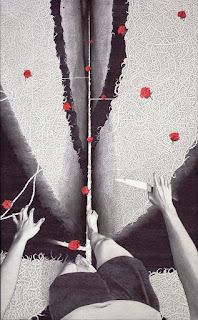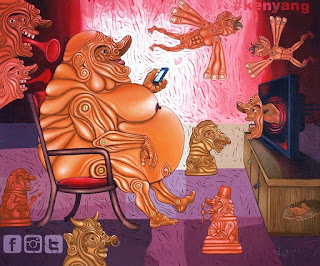In this tribute show to local poet Pyanhabib Rahman, artists are invited to test their “…capability in reading literary texts and transforming them into visual images”, and the results reveal a certain aesthetic symptomatic of the current state in Malaysian visual art. Counting the many animal and coffee pictures, figurative representations make up the majority of exhibits. Even non-painting works depict literal translations, such as Fadhli Ariffin’s vicious video of the artist as a chained dog, and Jamil Zakaria’s tongue-wagging chicken wire sculpture. Among earthy colours and cluttered compositions, Syahbandi Samat’s fine ballpoint drawing stands out with its clarity, ‘Hidup’ a beguiling scene that describes beautifully the verses of its accompanying poem ‘Semadi ii’.
| Image may be NSFW. Clik here to view.  |
| Syahbandi Samat - Hidup (2015) |
“aku imbang diri / atas rentang tali / direntang tanah datar / kemilau mata pisau / menyentak duri mawar” – Semadi ii (24 September 1983, Anak Alam), Pyanhabib
When mimicry is not the approach, however, a lacking execution in artworks fail to sustain the viewer’s gaze. The emptied-out guitar by Azam Aris, a superimposed projection by Kamal Sabran, and Poodien’s mirrored words, display clever intent but present an unattractive aesthetic. Rocks as transcript appear in a few works, as Faizal Suhif’s monoprint outdoes his mentor Jalaini Abu Hassan in creating an absorbing picture. Anne Samat’s black net background diminishes the effect of her crafty creations, while I wish a clean surface was used instead of a corroded one in Saharuddin Supar’s incisively cut steel.
| Image may be NSFW. Clik here to view.  |
| Saharuddin Supar - Luka-Luka Menyembuh (2015) |
“seperti siput mengembara; ketika air sedang surutaku mengembara begitu siput; dengan mulutpenuh lumpur terkapar; begitu aku jadi nanardengan mulut terbuka menghulur; lidah terbakar”
– Luka (21 March 1977, Kota Bharu), Pyanhabib, Balada Pyanhabib, pg. 9
| Image may be NSFW. Clik here to view.  |
| Adeputra Masri - Kenyang (2015) |
Adeputra Masri’s ‘Kenyang’ riffs on information overload caused by media technology, its grotesque mythical birds and chess pieces the perfect foil to the desperate poem ‘Lapar’. Moving on to another physiological need, carnal desire is depicted as a temptation in Latif Maulan’s private dance, and as a habitual preoccupation under the sheets by Mohd Akhir Ahmad. Sabihis Md Pandi’s wonderful ‘Taman’ presents this topic best with its garden of desire, as I did not find sex explicitly mentioned in Pyanhabib’s writings on display. In its efforts to fit many white walls, customary large format works fail to visually project poetry and its nuances. Forceful association of one poem per hanging impedes appreciation for both art forms, which reflects also the lack of care by presenters of Malaysian visual art. Indeed,
“maaf / kalau aku tersentuh / susumu yang penuh” – Taman (3 October 1980), Balada Pyanhabib, pg. 35
| Image may be NSFW. Clik here to view.  |
| Sabihis Md Pandi - Taman (2015) |